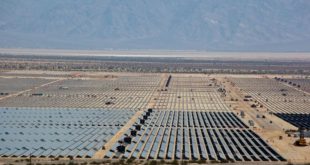By Daryl J. Ehrmantraut
Our future energy requirements depend on reaching the ‘holy grail’ of electricity generation – Finding a cheaper alternative to coal and other fossil fuels. The availability of an alternative energy source would also contribute significantly to energy self-sufficiency in North America.
Every hour more energy from the sun hits the earth than the world’s entire population consumes in a single year. Given this abundance, solar energy is our world’s most obvious energy choice. Why then, is less than 1% of our global electricity supply powered by solar energy? Because the industry has been unable to harness the three critical success factors for global solar deployment – high efficiency, low cost and high materials availability for deployment on a global scale.
Current solar photovoltaic (PV) technologies generate electrical power by converting solar radiation into an electric current using semiconductor material. The process involved is called the photovoltaic effect (PV). Today, solar PV cannot be realized on a worldwide scale because neither of the two main technologies presented today; crystalline silicon PV and thin-film PV, completely address the three critical success factors. Crystalline silicon PV possesses high efficiency using abundant materials but they are very expensive to manufacture. It wins on two of the 3 critical success factors. Thin-film PV on the other hand is cheap to manufacture but has low efficiency and relies on rare and toxic elements in its manufacture. It wins on one critical success factor. Furthermore most thin-film technologies use dangerous, toxic materials including cadmium telluride and indium among others.
Despite the challenges, the global market for solar PV technology is growing very rapidly. Some analysts predicting solar PV could contribute as much as 10-15% of our global electricity by 2050.
As we seek to move solar energy into the mainstream, we need to retain the industry’s green integrity and bypass the pitfalls of electronic waste. Creating safe, affordable solar energy solutions requires research and development that eliminates the sector’s reliance the scarce and dangerous elements that are in limited supply, toxic, difficult to mine, or found only in select, sometimes geopolitically unfriendly regions of the world.
At Quantum Solar Power Corp., we are developing NGD™ a solar PV device which we believe will address all 3 critical success factors –high efficiency, low cost and high scalability through the use of abundant non-toxic materials. We believe Quantum will win on all three critical success factors. Quantum’s revolutionary approach to solar PV design will revolutionize the solar power market. We invite other solar technology companies and manufacturers to join our quest to create safe, affordable solar technology solutions that will literally light up the lives of people across the world.
There is no doubt that our predicted energy needs have a “sunny” future. According to the American Solar Energy Society, U.S. manufacturing of PV components — wafers, cells, and modules — has increased substantially year-over-year, with growth rates demonstrated at 97%, 81%, and 62% respectively. In 2009, the U.S. solar industry grew 36% to nearly $4 billion and supported the addition of 17,000 new jobs.
It is important for our geopolitical future that we create a clean energy economy along with a strong energy policy. A sunny future for our children demands that we continue to create green sector jobs that replace our dependency on fossil fuels with renewable energy through wind turbines, hydro-electric power and solar photovoltaic technologies that make solar energy a globally deployable, environmentally smart energy source.
# # #
 About the author:
About the author:
Daryl J. Ehrmantraut is Chief Executive Officer, President & Director of Quantum Solar Power Corporation, which is developing a “Next Generation Device” (NGD™) photovoltaic technology. Mr. Ehrmantraut lives and works in Vancouver, Canada. He can be reached at [email protected]
 Alternative Energy HQ solar power for homes, wind energy, and bio fuel issues
Alternative Energy HQ solar power for homes, wind energy, and bio fuel issues






